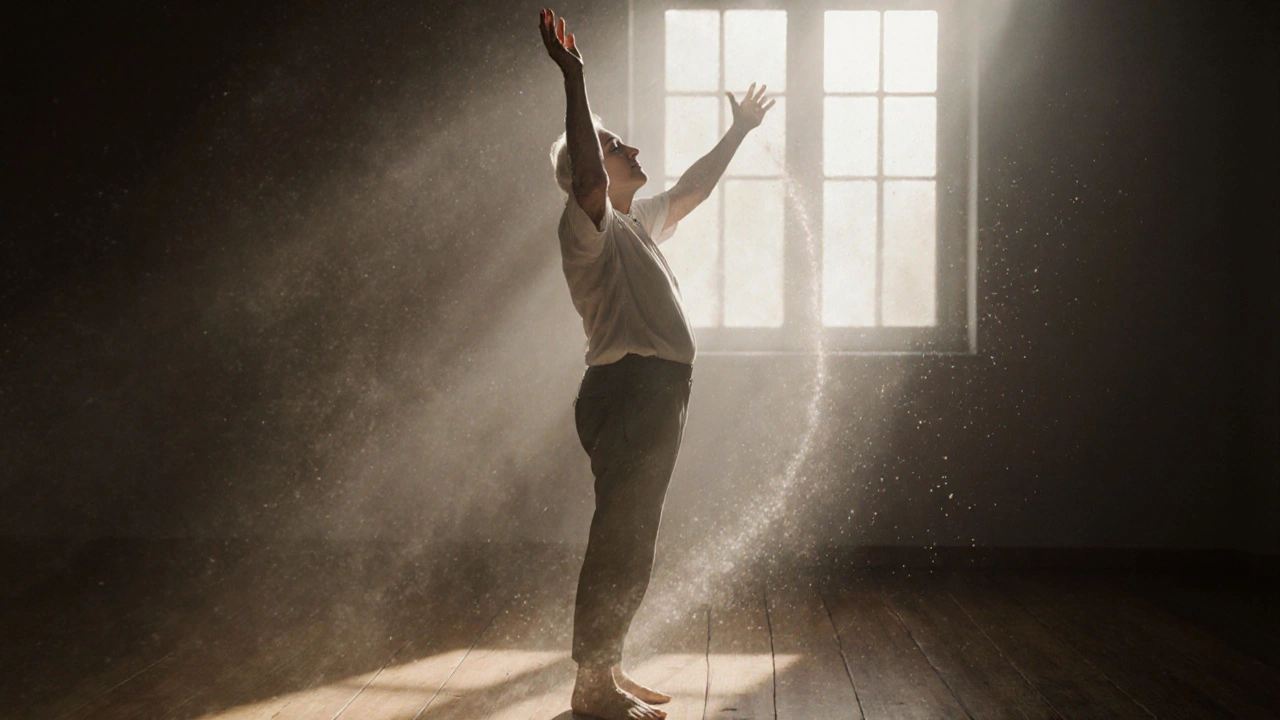Unlocking the Benefits of Trager Therapy for Deep Relaxation and Movement Freedom
 Nov, 18 2025
Nov, 18 2025
Movement Ease Assessment Quiz
How Movement-Friendly Is Your Body?
Take this 5-question assessment to discover your current movement ease level and learn how Trager therapy could help you experience more natural movement freedom.
How often do you feel physically stuck or unable to move freely?
How often do you notice tension in your shoulders or neck throughout the day?
How aware are you of your body's sensations during daily activities?
How often do you feel heavy or slow-moving when getting up from a chair or walking?
How often do you feel disconnected from your body's natural movement patterns?
Most people think of massage as a way to relieve sore muscles. But what if your body’s tension isn’t just in your muscles-it’s in how you move, breathe, and even think? That’s where Trager therapy comes in. Developed by Dr. Milton Trager in the 1950s, this gentle, non-invasive approach doesn’t just relax you-it rewires your nervous system to help you move with ease again. Unlike deep tissue work or chiropractic adjustments, Trager therapy doesn’t force change. It invites it.
What Is Trager Therapy?
Trager therapy is a form of psychophysical integration that combines gentle, rhythmic movements with mental imagery. Practitioners use their hands to guide your body through slow, wave-like motions-like rocking, stretching, and bouncing-while you lie fully clothed on a massage table. The goal isn’t to stretch muscles or crack joints. It’s to help your nervous system experience what freedom feels like.
Dr. Trager, a physician and physical therapist, developed this method after noticing that patients who relaxed deeply during treatment often kept their improvements longer than those who received aggressive therapies. He realized that real change happens when the mind stops resisting movement. So he designed a system that uses touch not to correct, but to remind.
The technique has two parts: mentastics (self-practice movements you do on your own) and tablework (the hands-on session). Both focus on cultivating a sense of lightness and ease. Think of it like learning to dance again-not by memorizing steps, but by rediscovering how your body wants to move naturally.
How Trager Therapy Works on Your Nervous System
Your body remembers tension-even when you don’t. Years of sitting at a desk, carrying stress, or recovering from injury can train your nervous system to keep muscles tight as a default. This isn’t laziness or weakness. It’s survival. Your brain thinks holding tension protects you.
Trager therapy interrupts that pattern. The practitioner uses soft, unpredictable movements that surprise your nervous system. When your arm is gently lifted and lowered like a feather, your brain doesn’t have time to brace. It starts to notice: Wait, I don’t have to hold this. That moment of surprise is where change begins.
Studies in neuroplasticity show that repeated exposure to new sensory input can rewire how the brain maps movement. A 2021 study published in the Journal of Bodywork and Movement Therapies found that participants in Trager sessions showed measurable improvements in joint range of motion and reduced muscle co-contraction-without any forceful stretching.
What makes Trager different is that it doesn’t ask you to try harder. You don’t need to flex, stretch, or hold a position. You just need to let go. The practitioner’s touch becomes a conversation, not a command.
Who Benefits Most from Trager Therapy?
Trager therapy isn’t a cure-all, but it’s incredibly effective for specific types of tension that other therapies miss.
- Chronic pain sufferers who’ve tried massage, chiropractic, or physical therapy with limited results often find Trager helps them finally relax into movement.
- Athletes use it to recover from overtraining without adding more stress to their bodies. It helps restore natural coordination after injury.
- People with anxiety or PTSD benefit because the gentle, non-invasive touch helps reset the fight-or-flight response. Many report feeling safer in their own skin after sessions.
- Older adults experience improved balance and reduced stiffness, making daily tasks like bending, reaching, or walking easier.
- Anyone who feels stiff, heavy, or disconnected from their body-even if they don’t have pain-can regain a sense of fluidity.
It’s especially helpful for people who’ve been told their pain is “all in their head.” Trager doesn’t dismiss that-it uses it. By changing how the brain interprets sensation, it turns mental resistance into physical freedom.

The Role of Mentastics: Movement as Medicine
Trager therapy doesn’t end when you leave the table. One of its most powerful tools is mentastics-simple, playful movements you practice on your own. These aren’t exercises. They’re invitations to explore.
For example, one mentastic involves imagining your arms are made of helium. You lift them slowly, letting gravity do the work. Another asks you to wiggle your fingers while lying down, noticing how the movement ripples through your shoulders and spine.
These movements are designed to be effortless. No repetition. No goal. No strain. Just curiosity. The idea is to retrain your brain to associate movement with pleasure, not effort.
People who practice mentastics regularly report feeling more connected to their bodies throughout the day. They notice themselves standing taller, breathing deeper, and moving without thinking about it. That’s the real goal: movement that feels automatic, not forced.
What to Expect in Your First Session
Your first Trager session lasts 60 to 90 minutes. You’ll lie on a padded table, fully clothed in loose, comfortable clothing. The practitioner will begin by talking with you about your goals and any areas of discomfort.
Then comes the touch. It’s not like a massage. There’s no pressure, no kneading, no deep tissue work. Instead, the practitioner uses their hands to gently lift, sway, and roll your limbs and torso. It feels like being rocked in water.
Many people fall asleep during sessions. Others feel a tingling sensation, warmth, or lightness. Some cry. That’s normal. Trager therapy doesn’t just release physical tension-it can unlock stored emotions.
Afterward, you might feel lighter, calmer, or even a little dizzy. That’s your nervous system adjusting. Most people notice improved mobility and reduced tension within hours. The effects build over time.
Trager vs. Other Bodywork Therapies
How does Trager compare to massage, Rolfing, or Feldenkrais?
| Method | Touch Style | Client Role | Primary Goal | Duration of Effects |
|---|---|---|---|---|
| Trager Therapy | Gentle, rhythmic, wave-like | Passive observer | Re-educate nervous system | Long-term, self-sustaining |
| Swedish Massage | Effleurage, kneading, friction | Relax | Relieve muscle tension | Short-term (hours to days) |
| Rolfing | Deep, structured pressure | Active participant | Realign fascia | Medium-term (weeks to months) |
| Feldenkrais | Minimal touch, guided movement | Active learner | Improve movement awareness | Long-term with practice |
Trager stands out because it requires no effort from you. You don’t have to stretch, breathe a certain way, or follow instructions. You just need to be present. That makes it uniquely accessible-even for people who feel too tired, injured, or anxious to engage in other therapies.

Real Results: Stories from People Who Tried It
Carol, 68, had been living with chronic lower back pain for 12 years. She’d tried acupuncture, physical therapy, and even surgery. Nothing stuck. After six Trager sessions, she stopped using her cane. “It wasn’t that the pain disappeared,” she said. “It was that I stopped fighting it. My body finally believed it was safe to move.”
Mark, a professional runner, developed hip stiffness after a marathon. His physiotherapist recommended stretching and strengthening. He hated it. He started Trager therapy and within three sessions, his stride felt effortless again. “I didn’t feel stronger,” he said. “I just felt like I remembered how to run.”
These aren’t outliers. Trager practitioners report that 80% of clients say they experience noticeable improvement after three to five sessions. The key? Consistency. Like learning a language, your body needs repeated exposure to the new pattern.
How to Find a Qualified Practitioner
Trager therapy is taught through a rigorous certification program. Look for practitioners certified by the Trager International Association. They’ve completed at least 300 hours of training, including anatomy, mentastics, and supervised sessions.
Many practitioners also work in integrative health clinics, wellness centers, or private practices. Some offer virtual mentastics coaching, but the hands-on tablework must be done in person.
Don’t be afraid to ask questions. A good practitioner will explain what they’re doing, why, and how you can continue the work at home. If they talk about “fixing” you or promise quick cures, walk away. Trager isn’t about fixing-it’s about remembering.
Getting Started: Your First Steps
If you’re curious, try one session. It’s not expensive-most range from $80 to $150, depending on location. You don’t need a referral. No special equipment. No preparation.
After your session, spend five minutes doing one mentastic. Lie down. Imagine your arms are made of feathers. Let them sink. Then lift them slowly, like you’re lifting smoke. Notice how your breath changes. That’s the beginning of change.
Trager therapy doesn’t promise miracles. It offers something quieter, and more powerful: the chance to feel at home in your own body again.
Is Trager therapy painful?
No. Trager therapy is not painful. The touch is always gentle, rhythmic, and non-invasive. You’re never pushed, stretched, or forced into any position. If you feel discomfort, you should speak up-the practitioner will adjust. Many people fall asleep during sessions because it feels so relaxing.
How many sessions do I need?
Most people notice a difference after one session, but lasting change usually takes three to five. For chronic issues, 6-10 sessions over several weeks is common. After that, monthly maintenance sessions help keep the gains. The goal isn’t lifelong dependency-it’s to teach your body to remember ease.
Can Trager therapy help with anxiety?
Yes. Because Trager works directly with the nervous system, it’s effective for anxiety, PTSD, and stress-related tension. The gentle, predictable touch helps the body feel safe. Many clients report feeling calmer, more grounded, and less reactive after sessions. It’s not a replacement for therapy, but it complements it well.
Do I need to be in good shape to try Trager?
No. Trager therapy is suitable for all ages and fitness levels. It’s commonly used with seniors, people recovering from surgery, and those with mobility limitations. The movements are adapted to your body’s needs-not the other way around.
Can I do Trager therapy at home?
You can’t replicate the hands-on tablework at home, but you can practice mentastics-simple, guided movements taught by your practitioner. These take just minutes a day and help reinforce the feelings of ease from your sessions. Many people say mentastics are what make the difference long-term.
